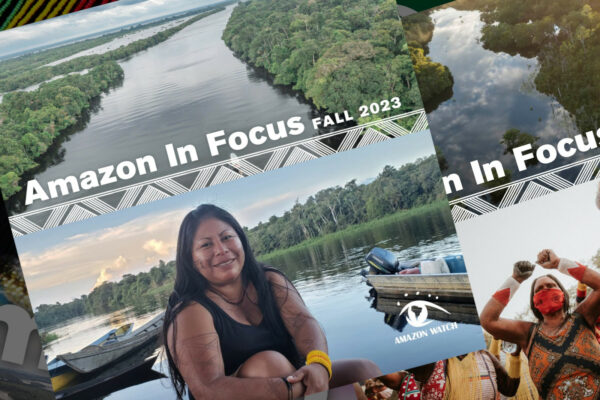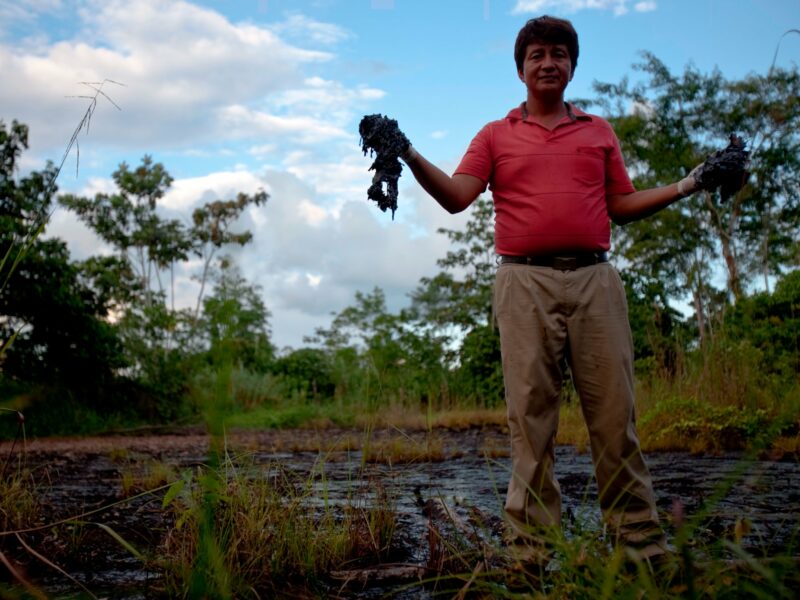Scientists Reveal Devastating Proof of Toxins In Suit Against ChevronTexaco in Ecuador
High Levels of Cancer-Causing Chemicals Found In “Remediated”Waste Pits
Quito, Ecuador– The harrowing results of one of the first judicial inspections of the areas contaminated by ChevronTexaco in Ecuador were announced on December 1, 2004 at a press conference at the Hotel Quito by scientist Edison Camino, one of the experts appointed by the Superior Court of Nueva Loja, Ecuador, where the “Trial of the Century” against oil giant ChevronTexaco, is taking place.
Mr. Camino was accompanied by Luis Yanza, legal coordinator for the Amazon Defense Front, 3 people affected by the contamination, as well as lawyer, Steven Donziger. They announced the results of the inspection that took place on September 1, 2004 at Sacha Camp, well #53. The results were submitted to the Court in a report on November 30, 2004.
In addition, the report submitted to the court contains information from 1996 that was never disclosed to the public. In 1996, Texaco, now ChevronTexaco, claimed that well #53 at the Sacha Camp was remediated. According to these secret documents obtained by Petroecuador, Ecuador’s state-owned oil company, Texaco self-reported that this site was contaminated. The documents reveal that cancer-causing chemicals were found at the site. Now, 8 years later, the inspection has revealed that this site is still contaminated at a level that is not permitted by in Ecuador, nor internationally.
The results directly undermine ChevronTexaco’s primary defense in the case – that it cleaned the pits and they pose no harm to residents. The trial is currently taking place in the small jungle town of Lago Agrio in Ecuador’s Amazon region and represents the first time rainforest dwellers have gained jurisdiction over a North American oil company.
“With this new evidence against ChevronTexaco’s “cleanup”, additional damage claims can be filed against the company”, said Luis Yanza, a spokesman for the Amazon Defense Front, who represents a coalition of five indigenous groups and thousands of local residents.
“The fact Texaco hid this life-threatening danger is outrageous and shocking,” said Yanza. “People are dying from cancer and Texaco’s silence was helping to kill them.”
The expert report, prepared by Edison Camino, an Ecuadorian engineer appointed by the judge, concluded that Texaco’s operations in Ecuador since the early 1970s in the area studied “shows evidence that the company used chemicals that are toxic and dangerous to humans, animals, agricultural crops and all of the ecosystems of the area. It also shows that the toxic waste pits were not remediated appropriately.”
For several years, local residents and health care workers have complained that the 627 open pits left by ChevronTexaco are the source of a surge in child leukemia, cancer of the uterus, spontaneous abortions, dizziness and vomiting. Four studies published in peer-reviewed academic journals suggest that cancer rates in the area Texaco operated are dramatically higher than historical norms for the region. A study of one community found cancer rates at 150% greater than historical norms, while another found 91 cases of child cancer.
Experts believe the cumulative environmental damage – done from 1972 to 1992 when Texaco systematically dumped 18.5 billion gallons of toxic formation waters – represents the worst oil-related contamination on earth and the worst ecological disaster of any type other than Chernobyl. Previous studies indicate the contamination has spread to rivers, streams, swamps, and thousands of square kilometers of groundwater.
The region has no potable water, forcing residents to drink from natural sources, most of which contain carcinogens from the dumping.
The results of well #53 that were submitted as a report to the court, were determined by scientists appointed by the Superior Court of Nueva Loja, independent experts, and Texaco’s own reports from 1996, reveal the following:
• TPHs – substances such toulene, xilene, florine, and benzene which are directly linked to cancer and damage to the central nervous system – were found.
• Levels of toxic contamination in the pits remained the same before and after the remediation. This supports the complaints of residents of the region and Ecuadorian environmental officials that ChevronTexaco only covered the pits with dirt and then planted vegetation to hide the toxic sludge.
• Levels of Cadmium, a substance that causes cancer of the prostate and kidney disease, was found at levels 10 times higher than the those permitted by Ecuadorian standards. These tests were done in 1996, and never disclosed by Texaco despite years of litigation and reported health problems.
• Levels of Cromium 6, another cancer-causing substance, that was used by Texaco to drill its wells, was found via independent testing at levels 8 times permitted in Ecuador. Because of its toxicity, Cromium 6 is also not permitted at any level in the U.S.
“This scientifically backed information confirms what the affected communities have been telling and showing us for years, that the contamination of their environment and the public health crisis facing them is a direct result of ChevronTexaco’s operations. ChevronTexaco can no longer say that we do not have evidence. The evidence is clear. It is now ChevronTexaco’s ethical and social responsibility to clean up the entire area it contaminated,” said Leila Salazar, Clean Up Ecuador Organizer for Amazon Watch.
Although the results in the first scientific report are of one site, Sacha 53, ChevronTexaco has admitted using the same clean-up methods at each of its sites and preliminary analysis from other sites shows similar levels of contamination. Formal reports for the other inspected sites are expected to be released in the coming weeks.
ChevronTexaco claims that its practices were proper for a tropical rainforest environment, and have not caused harm. However, the company has never produced any evidence that it used the same methods elsewhere and has never come up with an alternative explanation for the surge in cancers. Such methods of waste disposal were outlawed in the United States in 1919.
Steven Donziger, one of the lawyers for those affected, called the new evidence “a sign of the unraveling of a major corporate cover-up of one of the worst industrial crimes in history. This was planned by corporate executives and their motive was greed.”
“This is similar to what happened to the tobacco industry,” said Donziger. “For years the industry denied smoking caused cancer even though all evidence was to the contrary, just like ChevronTexaco continues to deny that its dumping in Ecuador causes environmental damage and cancer despite massive evidence to the contrary.”
Legal scholars are watching the case closely because it represents the first time rainforest dwellers have forced an American oil company to stand trial for environmental damage. The trial began in October 2003 and is expected to last another 12 months while the judge and technical experts inspect dozens of contaminated sites.
For more information go to www.amazonwatch.org or www.amazoniavive.org













